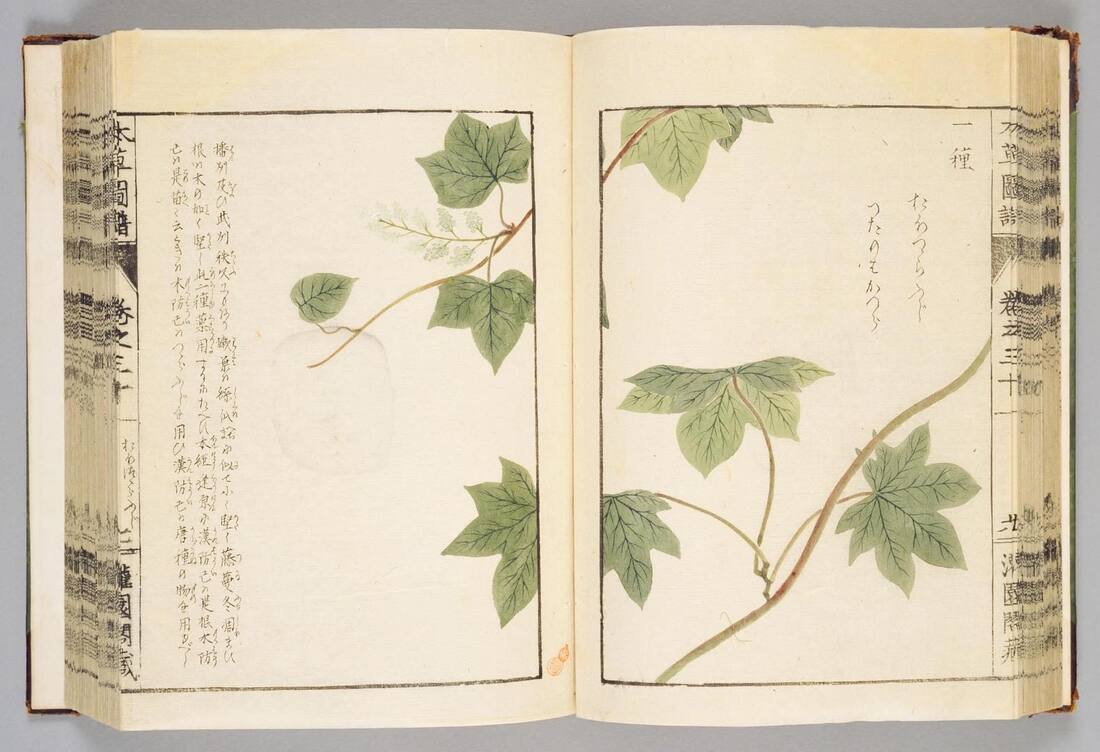Sinomenium, Qing Feng Teng 青风藤
Qing Feng Teng (TCM) Iwasaki, T., Honzo zufu (1916-1921)
Iwasaki, T., Honzo zufu (1916-1921)Botanical name:
Sinomenium acutum, Sinomenium acutum var. cinerum
Parts used:
Vine
Temperature & Taste:
Neutral. Bitter, Pungent
Classification:
D. Clear Wind and Damp
Uses:
1. Clears Wind-Damp, Stops Pain:
-painful obstruction of the muscle and joints; Arthritis, Rheumatoid Arthritis
-edema, swelling and pain of the legs
2. Settles Wind:
-Paralysis
-Hypertension (strong proven effect)
–Arrhythmia
-Pruritus
3. Stops Cough and Wheezing:
-Cough, Spasmodic Cough, Wheezing
-this is not a traditional use but has been demonstrated by research
Dose:
It is often added to alcohol or used in tincture form.
Decoction: 6–12 grams
Comment:
Sinomenium Qing Feng Tang has demonstrated potent analgesic effect, being up to 40% as strong as morphine but with no dependence and a slower tolerance.
It has also demonstrated a potent anti-hypertensive effect causing a rapid decrease in blood pressure. However, tolerance develops with repeated administration.
Substitutes:
Stephania Han Fang Ji
Main Combinations:
1. Wind-Damp muscle and joint pain, Rheumatoid Arthritis:
i. Sinomenium Qing Feng Tang with Clematis Wei Ling Xian, Angelica pubescens Du Huo
ii. Sinomenium Qing Feng Tang with Cyathula Chuan Niu Xi, Dipsacus Xu Duan, Drynaria Gu Sui Bu
2. Hypertension, Sinomenium Qing Feng Tang with Mistletoe (Sang Ji Sheng), Self Heal (Xia Ku Cao)
Major Formulas:
Cautions:
None noted
Toxicity:
1. Occasional cases of eczema have been reported after use.
2. Agranulocytosis Induced by Sinomenine Hydrochloride.
Main Preparations used:
GENERAL / REVIEW:
–Sinomenium acutum: A Comprehensive Review of its Botany, Phytochemistry, Pharmacology and Clinical Application.
–Sinomenium acutum: a review of chemistry, pharmacology, pharmacokinetics, and clinical use.
–Bioactivities and Mechanisms of Action of Sinomenine and Its Derivatives: A Comprehensive Review.
–From mundane to classic: Sinomenine as a multi-therapeutic agent.
–A review on pharmacokinetics of sinomenine and its anti-inflammatory and immunomodulatory effects.
ANTIOXIDANT:
–Involvement of the Keap1-Nrf2-ARE pathway in the antioxidant activity of sinomenine.
ANTI-INFLAMMATORY:
–Identification of anti-inflammatory components in Sinomenii Caulis based on spectrum-effect relationship and chemometric methods.
–Anti-inflammatory Effects of Sinomenium Acutum Extract On Endotoxin-induced Uveitis in Lewis Rats.
ANALGESIC:
–Analgesic Mechanism of Sinomenine against Chronic Pain.
–Sinomenine produces peripheral analgesic effects via inhibition of voltage-gated sodium currents.
–Analgesic effect of sinomenine in rodents after inflammation and nerve injury.
IMMUNOMODULATORY:
–Investigating the therapeutic potential of sinomenine in rheumatoid arthritis: anti-inflammatory, antioxidant, and immunomodulatory mechanisms.
–A review on pharmacokinetics of sinomenine and its anti-inflammatory and immunomodulatory effects.
NEUROPROTECTIVE:
–Neuroprotective Effects of Sinomenine on Experimental Autoimmune Encephalomyelitis via Anti-Inflammatory and Nrf2-Dependent Anti-Oxidative Stress Activity.
ANTI-DEPRESSANT:
–Anti-Depressant-Like Effect of Sinomenine on Chronic Unpredictable Mild Stress-Induced Depression in a Mouse Model.
–The antidepressant-like effects of sinomenine in mice: a behavioral and neurobiological characterization.
ALZHEIMER’S DISEASE:’
–Sinomenine regulates the cholinergic anti-inflammatory pathway to inhibit TLR4/NF-κB pathway and protect the homeostasis in brain and gut in scopolamine-induced Alzheimer’s disease mice.
HEPATOPROTECTIVE:
–Evaluation of the Reparative Effect of Sinomenine in an Acetaminophen-Induced Liver Injury Model.
ARTHRITIS:
–Bone protective effect of sinomenine against monosodium iodoacetate induced knee and hip injury in rat model: an inflammatory pathway.
–Sinomenine ameliorates arthritis via MMPs, TIMPs, and cytokines in rats.
–Effect of sinomenine on collagen-induced arthritis in mice.
RHEUMATOID ARTHRITIS:
–Sinomenine ameliorates fibroblast-like synoviocytes dysfunction by promoting phosphorylation and nuclear translocation of CRMP2.
–Investigating the therapeutic potential of sinomenine in rheumatoid arthritis: anti-inflammatory, antioxidant, and immunomodulatory mechanisms.
–Integrated Network Pharmacology and Experimental Validation Approach to Investigate the Mechanisms of Stigmasterol in the Treatment of Rheumatoid Arthritis.
–Exploring the active ingredients and potential mechanisms of action of sinomenium acutum in the treatment of rheumatoid arthritis based on systems biology and network pharmacology.
–Recent Advancements in Drug Delivery of Sinomenine, A Disease-Modifying Anti-Rheumatic Drug.
–Compounds with NO Inhibitory Effect from the Rattan Stems of Sinomenium acutum, a Kind of Chinese Folk Medicine for Treating Rheumatoid Arthritis.
–Anti-inflammatory activities of Chinese herbal medicine sinomenine and Liang Miao San on tumor necrosis factor-α-activated human fibroblast-like synoviocytes in rheumatoid arthritis.
–Protective effect of sinomenine on cartilage degradation and chondrocytes apoptosis.
BENIGN PROSTATIC HYPERTROPHY (BPH):
–Sinomenine Hydrochloride Can Ameliorate Benign Prostatic Hyperplasia by Lowering the 5α-Reductase 2 Level and Regulating the Balance between the Proliferation and Apoptosis of Cells.
DIABETIC NEUROPATHY:
–Sinomenine alleviates diabetic peripheral neuropathic pain through inhibition of the inositol-requiring enzyme 1 alpha-X-box binding protein 1 pathway by downregulating prostaglandin-endoperoxide synthase 2.
CANCER:
–Cytotoxic activities of alkaloid constituents from the climbing stems and rhizomes of Sinomenium acutum against cancer stem cells.
–The anti-tumor potential of sinomenine: a narrative review.
–Mechanism Underlying Antitumor Effects of Sinomenine.
–New alkaloids and cytotoxic principles from Sinomenium acutum.
BLADDER:
–Sinomenine reverses multidrug resistance in bladder cancer cells via P-glycoprotein-dependent and independent manners.
BREAST:
–Anti-breast cancer sinomenine derivatives via mechanisms of apoptosis induction and metastasis reduction.
CERVICAL:
–Rheumatoid arthritis drug sinomenine induces apoptosis of cervical tumor cells by targeting thioredoxin reductase in vitro and in vivo.
–Sinomenine hydrochloride sensitizes cervical cancer cells to ionizing radiation by impairing DNA damage response.
COLON:
–Sinomenine, a COX-2 inhibitor, induces cell cycle arrest and inhibits growth of human colon carcinoma cells in vitro and in vivo.
GASTRIC:
–Sinomenine inhibits proliferation of SGC-7901 gastric adenocarcinoma cells via suppression of cyclooxygenase-2 expression.
GLIOBLASTOMA:
–Cannabisin D from Sinomenium Acutum Inhibits Proliferation and Migration of Glioblastoma Cells through MAPKs Signaling.
KIDNEY:
–The pro-apoptosis effect of sinomenine in renal carcinoma via inducing autophagy through inactivating PI3K/AKT/mTOR pathway.
LUNG:
–Overcoming cisplatin resistance of human lung cancer by sinomenine through targeting the miR-200a-3p-GLS axis.
–Sinomenine Inhibits Migration and Invasion of Human Lung Cancer Cell through Downregulating Expression of miR-21 and MMPs.
MELANOMA:
–Sinomenine inhibits the growth of melanoma by enhancement of autophagy via PI3K/AKT/mTOR inhibition.
CHEMOTHERAPY TOXICITY:
–Protective effects of sinomenine against doxorubicin-induced nephrosis in rats.
